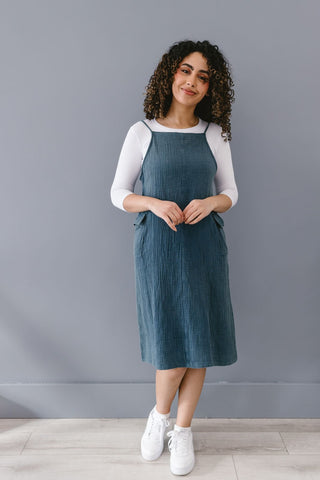Amidst the whirl of fashion trends, the art of layering shirts remains an evergreen skill, always in vogue and ever adaptable. Thoughtful layering can accentuate your best features. Layering shirts are especially useful if you care about dressing modestly, as they add the coverage you want to any of your outfits.
When layering, you’ll want to pick an undershirt that complements your outfit and body type. This guide will tell you everything you need to know about what kind of layering shirts you need for your body shape.
The hourglass shape: balancing proportions
For the hourglass figure, pay equal attention to the upper and lower body to create symmetrical harmony. Choose tops that define the waist while accentuating your natural curves. This strategic styling brings focus to a narrowed waistline, casting a balanced silhouette.
Layer with intent on an hourglass frame; highlight the contours without overwhelming them. Opt for fitted shirts that follow the body's natural shape, seamlessly blending with tapered waist garments. The layered look should complement, not conceal, the hourglass proportions.
When considering outer layers, aim to add structure without bulk. For example, a tailored blazer that cinches at the waist complements an underlying fitted shirt, further defining the hourglass shape. With proper layering, the clothes work in favor of the figure's symmetry, enhancing rather than overshadowing your distinct contours.
The pear shape: highlighting curves
The pear body shape flourishes with layers that celebrate the lower body’s curves while defining the waist. A strategic selection of shirts forms an elegant base you can tastefully layer for a modest yet flattering profile.
For the upper body, opt for A-line or empire-cut layers that gently flare out, balancing the broader hips and enhancing the waist. This creates a harmonious transition that draws the eye upwards. Teaming a fitted undershirt with a voluminous bottom showcases the midsection without adding undue volume.
Incorporating varying lengths in your layered pieces is a transformative styling technique for the pear shape. A shorter jacket or cardigan that highlights the waist, when worn over a longer tunic, delineates the proportions effectively, resulting in an elongated, graceful silhouette. Try structured jackets to emphasize your shoulders or different necklines to emphasize the bust to make these features look bigger.
Your ensemble can shine with a careful choice of textures and colors. Lighter and brighter colors draw attention to the upper body, while dark, solid hues for pants or skirts slim the lower half.
The apple shape: creating visual harmony
For the apple body type, strategic layering is key to achieving a balanced silhouette.
- Start with a slim-fitting base layer to smooth out your midsection without adding bulk.
- Opt for a mid-length top layer, like a tailored blazer, that gently skims the body and falls below the hip to elongate the torso.
- Choose pieces with structure to define the shoulders and bust, drawing the eye upwards.
- Incorporate visually interesting elements like prints or textures on the upper half to keep attention on your best features. A well-layered outfit considers both comfort and the nuances of your shape. Keeping these layers proportional creates a stylish and sophisticated look.
The rectangle shape: creating curves
If you have a rectangular body shape, your shoulders, waist, and hips are all relatively similar in width. The key to layering for this body type is to create the illusion of curves and add definition to your figure. Here are some tips to help you achieve a more balanced and shapely look:
- Choose fitted base layers: Start by selecting fitted base layers that hug your body and create a smooth foundation. These will provide a sleek and streamlined silhouette, serving as the starting point for your layered outfit.
- Add volume on top: To create the illusion of curves, focus on adding volume to your upper body. Opt for tops with ruffles, pleats, or other details that add visual interest and create the appearance of a fuller bust and shoulders. Layering a loose-fitting blouse or a flowy cardigan over your base layer adds volume and creates a more defined waistline.
- Belt it up: Belting your layers is a great way to accentuate your waist and create an hourglass shape. Choose a wide belt and cinch it at your natural waistline to add definition. This simple trick creates a feminine and shapely silhouette.
- Experiment with lengths: Play with different lengths when layering shirts to create dimension and break up the straight lines of your body. For example, try layering a cropped jacket or a shorter top over a longer base layer. This will draw attention to your waist and create the illusion of curves. You can also experiment with asymmetrical hemlines or high-low tops to add visual interest and create a more dynamic look.
- Embrace patterns and textures: Don't shy away from patterns and textures when layering for a rectangular body shape. Opt for tops with horizontal stripes, bold prints, or textured fabrics to add visual width and create the illusion of curves. Mixing and matching different patterns and textures also helps add depth and dimension to your overall look.
Remember, the goal of layering for a rectangular body shape is to create curves and add definition to your figure. Following these tips and experimenting with different layering techniques can enhance your natural shape and create stylish and flattering outfits.
Sleeve lengths
When it comes to layering shirts, one important aspect to consider is the sleeve length. The right sleeve length adds style and visual interest to your outfit and helps you achieve the desired level of coverage and comfort. Here are some different sleeve lengths to consider when layering shirts:
Short sleeves
Short-sleeved shirts are a versatile option for layering. Wear these as a base layer or paired with other sleeve lengths for a trendy and layered look. For example, layer a short-sleeved undershirt under a long-sleeved sheer blouse to add depth and dimension to your outfit.
Three-quarter sleeves
Three-quarter sleeves are a popular choice for layering as they provide coverage while still allowing you to show off your wrists and any bracelets or watches you may be wearing. They are also great for transitional seasons when you want arm coverage without feeling too bundled up. Layer a three-quarter sleeve top with a sleeveless vest or a lightweight jacket for a stylish and balanced look.
Long sleeves
Long-sleeved shirts are a classic choice for layering, especially during colder months. They provide ample coverage and warmth while allowing you to experiment with different layering techniques. Layer a long-sleeved undershirt under a sweater or a button-down shirt for added warmth and style. Alternatively, try layering a long-sleeved shirt under a sleeveless dress or jumpsuit to extend its wearability throughout the seasons and create visual interest.
Sleeveless
Sleeveless shirts are perfect for layering, providing a blank canvas for showcasing other sleeve lengths and styles. Layer a sleeveless shirt under a cardigan or a blazer for a polished and professional look. For a chic and modern outfit, you can also layer a sleeveless top over a long-sleeved shirt or turtleneck. The options are endless when it comes to layering with sleeveless shirts.
Remember, the sleeve length you choose for layering depends on the look you want to achieve and the level of coverage you desire. Experiment with different sleeve lengths and styles to create unique and personalized layered outfits that suit your body type and personal style.
The power of necklines
The neckline on a shirt significantly influences the visual proportions of the body. A deeper plunge elongates the neck and accentuates a slender torso, while a higher neckline offers a subtle canvas for layering without overpowering. Importantly, neckline choice draws the eye to different features, framing the face and enhancing the upper body silhouette.
The scoop neck is a versatile choice — you can have it play a supporting role in a layered ensemble or stand as the primary feature. This neckline is particularly complimentary to fuller busts.
As for v-necks, they offer a universal appeal, drawing the eye down in a way that creates a sleek line. This makes them a go-to option for an array of body types, particularly when paired with an understated layer to lend a touch of modest elegance without overwhelming the central garment.
High crewnecks look great with textured layering pieces, providing a pristine backdrop to showcase detailed collars and striking jewelry.
Turtlenecks, meanwhile, offer a streamlined and sophisticated look, especially when incorporated into a layered outfit. If you want to make your bust look better, a turtleneck is a good neckline to try. This choice is impeccable for your winter wardrobe and creates a svelte and refined appearance.
Step up your layering game with Halftee
The transformative ability of layering shirts is not limited to aesthetics alone; it's a form of self-expression that empowers. Halftee elevates this art form with products tailored for every body type, ensuring that comfort aligns with style.
Every garment we offer is designed with the intention of blending seamlessly with your existing wardrobe, endorsing versatility while delivering on modesty. With Halftee, the fusion of practicality and elegance is a promise we keep, crafting pieces that aspire to meet your personal style narrative.
If you want a modest layering shirt or undershirt without the bulk, look no further than Halftee. It’s time to redefine your ensemble with our expertly curated line — shop at Halftee today!







0 comments